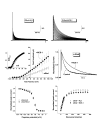Functional and pharmacological characterization of a Shal-related K+ channel subunit in Zebrafish
- PMID: 18261223
- PMCID: PMC2270284
- DOI: 10.1186/1472-6793-8-2
Functional and pharmacological characterization of a Shal-related K+ channel subunit in Zebrafish
Abstract
Background: K+ channels are diverse; both in terms of their function and their molecular composition. Shal subunits were first described in Drosophila. There are three mammalian orthologs, which are members of the Kv4 subfamily. They are involved in neuronal firing patterns as well as control of the cardiac action potential duration.
Results: Here, we report the biophysical and pharmacological characterization of zShal3, which is the ortholog of the mammalian Kv4.3 subunit, which in mammals is involved in action potential repolarization and gives rise to neuronal A-type K+ currents involved in somatodendretic signal integration.
Conclusion: We demonstrate that zShal has similar functional and pharmacological characteristics compared to Kv4.3 and it is similarly regulated by pharmacological agents and by the Kv4 accessory subunit, NCS-1.
Figures




References
-
- Warren KS, Baker K, Fishman MC. The slow mo mutation reduces pacemaker current and heart rate in adult zebrafish. Am J Physiol Heart Circ Physiol. 2001;281:H1711–H1719. - PubMed
-
- Ebert AM, Hume GL, Warren KS, Cook NP, Burns CG, Mohideen MA, Siegal G, Yelon D, Fishman MC, Garrity DM. Calcium extrusion is critical for cardiac morphogenesis and rhythm in embryonic zebrafish hearts. Proc Natl Acad Sci U S A. 2005;102:17705–17710. doi: 10.1073/pnas.0502683102. - DOI - PMC - PubMed
Publication types
MeSH terms
Substances
Grants and funding
LinkOut - more resources
Full Text Sources
Molecular Biology Databases

